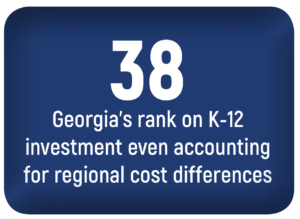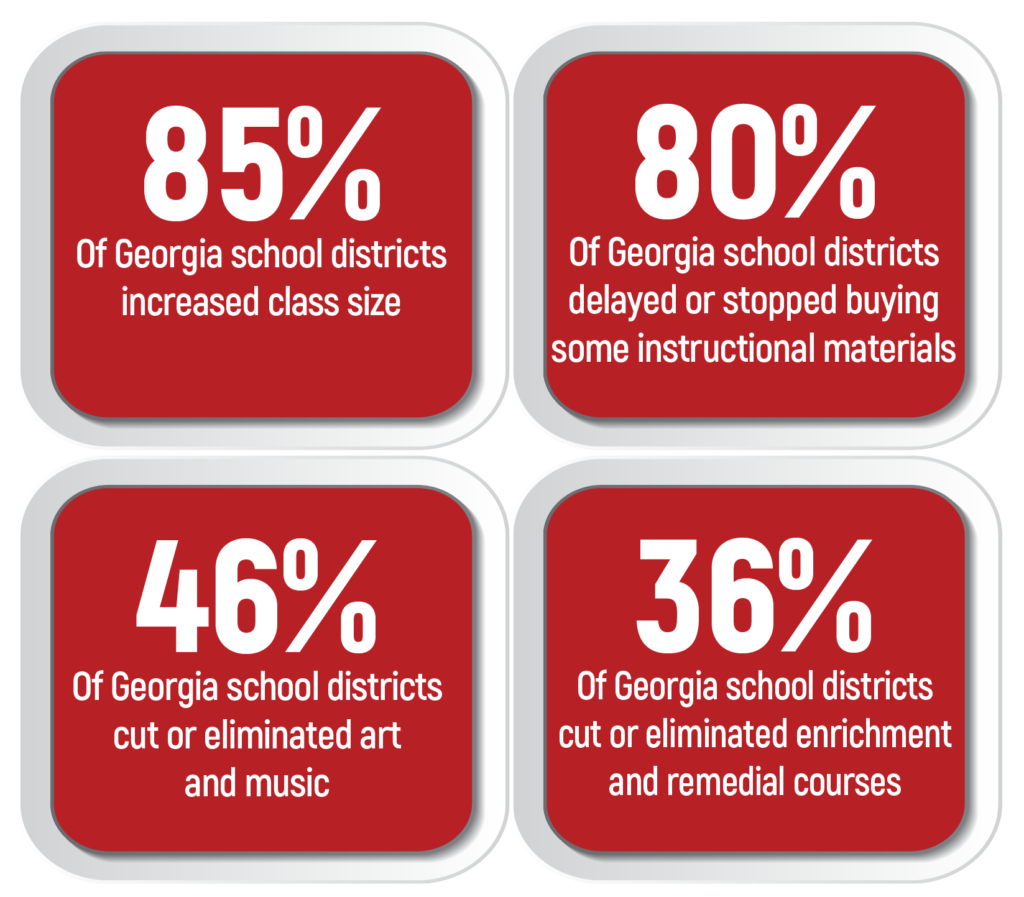 For Georgia to grow a strong workforce and economy, the state needs a rock-solid foundation. That starts with relentless investment in early education and K-12 public schools. A workforce able to compete in the 21st century needs a constant supply of young people on track to become self-sufficient contributors to society. Students need both specific skills to one day enter the workforce and a deeper love of learning that leads to new ideas, products, businesses and richer lives in general.
For Georgia to grow a strong workforce and economy, the state needs a rock-solid foundation. That starts with relentless investment in early education and K-12 public schools. A workforce able to compete in the 21st century needs a constant supply of young people on track to become self-sufficient contributors to society. Students need both specific skills to one day enter the workforce and a deeper love of learning that leads to new ideas, products, businesses and richer lives in general.
Update Georgia’s K-12 funding formula to meet today’s rigorous standards.
Well-funded public schools help children get a good start in life. Adequate and sustained investment in K-12 schools is shown to improve children’s performance in the classroom and increase their future earnings, with students from low income families showing the most gain. But Georgia ranks 38th in the nation in school spending and invests $1,965 less per student than the national average, even after accounting for regional cost differences.[57]
State lawmakers also took an axe to public school budgets over the past 15 years, underfunding the state’s K-12 funding formula by more than $9 billion since 2003.[58] The shortfall made it hard for districts to keep class sizes down, invest in reform strategies or provide students with the extra support they need to reach the state’s education goals. Lawmakers restored some of the lost funds as the economy improved, yet still shortchanged districts by $167 million in the 2018 budget.
Due to state budget cuts, from 2009 to 2014…

To power a more educated workforce in the future, Georgia needs to change course. The state’s current formula for funding public school students is a legacy of the 1985 General Assembly and is substantially unchanged since then. Meanwhile, students are expected to know and do far more today than 30 years ago.
Georgia needs to modernize its rickety funding formula so it reflects the true costs of educating every child to today’s rigorous standards. Recent efforts to revise the formula focused solely on reallocating existing funding levels, rather than boosting them to the higher amount that today’s economy requires. A renewed and comprehensive approach is needed so lawmakers can identify the true cost to help all students reach state standards and provide local communities with the resources necessary to do so.
More details: “School District Funding Squeeze Continues,” GBPI, June 2017.
Empower districts to invest in proven solutions, especially in high-need schools.
 Every student in Georgia should finish high school prepared to enter and complete a training or degree program at a technical college or a university. That sets them on a path to financial security and helps the state foster economic growth. Yet today, too many children fall short of the state’s educational benchmarks, especially young people from low-income families or communities of color that Georgia historically blocked from opportunity.
Every student in Georgia should finish high school prepared to enter and complete a training or degree program at a technical college or a university. That sets them on a path to financial security and helps the state foster economic growth. Yet today, too many children fall short of the state’s educational benchmarks, especially young people from low-income families or communities of color that Georgia historically blocked from opportunity.
Seventy percent of Georgia school district leaders say poverty is the most significant out-of-school issue, and most schools where at least half of students are low-income are graded as failing by state leaders.[59] According to state education data, 99 percent of extreme-poverty schools, where at least 75 percent of students are low-income, earned a D or F on Georgia’s K-12 school grading system. The same is true of only 5.4 percent of low-poverty schools, where 25 percent or less of students are low-income.[60]
 Students struggle in higher-poverty schools because children face serious challenges at home that often interfere with their learning. Impediments such as insufficient food on the table, erratic housing arrangements or low parental support can cause children to lose focus or degrade their mental health. In-school learning factors, such as teacher retention, access to instructional materials and expended course offerings, also tend to be subpar due to lack of resources in high-poverty and high-minority schools.
Students struggle in higher-poverty schools because children face serious challenges at home that often interfere with their learning. Impediments such as insufficient food on the table, erratic housing arrangements or low parental support can cause children to lose focus or degrade their mental health. In-school learning factors, such as teacher retention, access to instructional materials and expended course offerings, also tend to be subpar due to lack of resources in high-poverty and high-minority schools.
Georgia cannot afford to leave these students behind, if only for the sake of the state economy. More than 60 percent of children in Georgia’s K-12 schools today are eligible for free- or reduced-price lunch, up from 45 percent in 2002.[61] At the same time, Georgia companies struggle to find enough educated workers. Without improving education for low-income students, too many Georgians will see their talents go untapped and the state’s economy will struggle to cope.
To turn the tide, Georgia leaders can deploy a comprehensive approach that combines strategies to reduce poverty among students and their families over the long term while strengthening the schools they attend today. The most promising approach is to give districts the resources to tailor local strategies around what we know works: great principals, decent pay and training for teachers, more targeted support for at-risk students and other interventions.
“High quality education will not only expand economic opportunity for residents, but also likely do more to strengthen the overall state economy than anything else a state government can do.”
– Economic Analysis & Research Network
More details: “Tackle Poverty’s Effects to Improve School Performance,” GBPI, December 2017.








